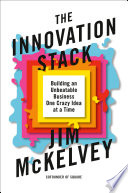

The core premise of 'The Innovation Stack' is the concept of the innovation stack itself. This refers to the unique combination of innovations that a company creates to solve a specific problem in a novel way. Unlike traditional businesses that may rely on existing frameworks, the innovation stack is built from the ground up, layer by layer, with each layer representing a new solution to a problem. This approach allows companies to differentiate themselves in the marketplace and create a competitive advantage. For example, when Square was founded, it not only developed a new payment processing system but also addressed various challenges such as hardware, software, and customer service. Each innovation was interconnected, forming a stack that made it difficult for competitors to replicate. The idea emphasizes that true innovation often comes from building on previous ideas and creating a unique solution that addresses multiple issues simultaneously.
Continue readingOne of the key takeaways from the book is the significance of problem-solving in the innovation process. The author argues that successful entrepreneurs focus on solving real problems rather than just pursuing profit. This mindset encourages a deeper understanding of customer needs and fosters creativity in developing solutions. The book provides examples of various companies that have thrived by prioritizing problem-solving over traditional business metrics. For instance, Square identified the pain points of small businesses struggling with payment processing and created a solution that simplified the process. By focusing on the problem, entrepreneurs can discover opportunities that others may overlook, leading to innovative products and services that resonate with customers.
Continue readingFailure is often viewed negatively in the business world, but 'The Innovation Stack' posits that failure is a crucial component of the innovation process. The author emphasizes that every successful entrepreneur has faced setbacks and challenges on their journey. These failures provide valuable lessons and insights that can lead to greater innovation. For example, Square's journey was fraught with obstacles, but each failure taught the team something new about their product and market. The book encourages readers to embrace failure as a stepping stone to success, highlighting that resilience and adaptability are essential traits for innovators. By learning from mistakes, entrepreneurs can refine their ideas and ultimately create more robust solutions.
Continue readingInnovation does not occur in a vacuum; it thrives in a supportive ecosystem. The book discusses the importance of surrounding oneself with like-minded individuals, mentors, and collaborators who can provide guidance and support throughout the innovation journey. The author shares stories of successful entrepreneurs who leveraged their networks to overcome challenges and gain insights. For instance, Square's founders sought advice from experienced entrepreneurs and industry experts, which helped them navigate the complexities of building their business. The idea here is that innovation is often a collective effort, and fostering a community of support can lead to greater success.
Continue readingPersistence is a recurring theme in 'The Innovation Stack.' The author illustrates that the path to innovation is rarely straightforward, and setbacks are inevitable. Successful entrepreneurs demonstrate unwavering determination and a willingness to push through obstacles. The book provides examples of companies that faced significant challenges but persevered, ultimately achieving their goals. For instance, Square encountered numerous regulatory hurdles and technical difficulties, but the team's persistence allowed them to refine their solutions and emerge stronger. This idea reinforces the notion that innovation requires grit and a long-term vision, encouraging readers to stay committed to their goals despite difficulties.
Continue readingIn 'The Innovation Stack,' the author highlights the interconnectedness of various innovations within a company. Each layer of the innovation stack builds upon the previous one, creating a cohesive solution that addresses multiple aspects of a problem. This interconnectedness is crucial for creating a comprehensive product or service that meets customer needs effectively. The book discusses how successful companies often develop a range of innovations that work together seamlessly. For example, Square not only created a payment processing system but also developed tools for inventory management, customer engagement, and analytics. This holistic approach allows businesses to offer more value to customers and strengthens their competitive position.
Continue readingThe final key idea in 'The Innovation Stack' is the importance of fostering a culture of innovation within an organization. The author emphasizes that innovation should not be confined to a specific team or department; rather, it should be ingrained in the company's culture. This involves encouraging creativity, open communication, and collaboration among employees. The book provides examples of companies that have successfully cultivated a culture of innovation, leading to continuous improvement and growth. For instance, Square empowered its employees to contribute ideas and solutions, resulting in a dynamic and innovative work environment. This idea underscores the notion that a thriving culture of innovation can drive long-term success and adaptability in a rapidly changing market.
Continue reading